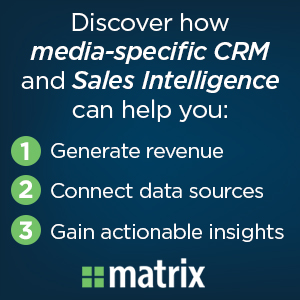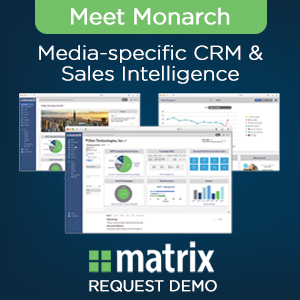Ad Decisions Driven by Better Data

Sponsored Content from Matrix
Today’s advertisers have more options than ever before. Choices for television viewers are expanding due to an ever-growing array of FAST (Free, Ad-Supported Television) linear channels and on-demand OTT services that offer an astonishing variety of fully or partially ad-supported tiers. Broadcasters also have a range of other ad-supported products to sell, including advertising on their websites and other public-facing properties such as social media accounts and sponsored content outlets.
Making decisions about where to place ads has become more complicated for advertisers. Long gone are the days when simple CPM/GRP (cost per thousand/gross rating point) analysis drove ad buying decisions. Instead, advertisers are looking for actionable data to use when developing RFPs for ad placements. Measuring CPI (cost per impression) is increasingly possible on new technology platforms, particularly for OTT and on-demand content. Click-through rates can also be measured in many instances, particularly for viewers using CTV (connected TV) devices. Note that a growing number of consumers use devices such as a Roku, Amazon Fire Stick, Apple TV, or Google Chromecast for older displays that do not have built-in CTV capabilities.
Broadcasters and media companies can benefit by upgrading their infrastructure to enhance the range of viewer data that their media sales organizations can provide to advertisers. One step that can greatly improve information flows is to simplify collecting and organizing the streams of data generated by new ad technologies, including web sites and social media platforms. Many of these outlets provide comprehensive data sets that can report on viewer locales, viewing habits such as page count and view duration, click-thru rates, incoming link sources, and other viewer activities.

Automating the delivery of ad performance data can further enhance the benefits for advertisers. By eliminating manual processes, the timeliness and accuracy of the data can be improved. Normalizing the results can also improve advertiser experience by making data sets easier to compare across different media types. Media-focused ad sales platforms such as the Monarch system from Matrix Solutions offer ad performance data integration and reporting. These tools can help maximize value of ad inventory by helping advertisers make better-informed choices.
Of course, there are a few challenges that need to be addressed in providing actionable data to advertisers. One challenge is correlating impressions across different media channels to measure overall reach of an advertising program, and to ensure that results are reported in formats that are easy to compare. A recent market study showed that 78 percent of media salespeople report data inconsistencies as their number one frustration. Another highly desirable objective is expanding the range of metrics provided to support consumer conversion rate measurement where possible.
“Modern advertising campaigns are frequently designed to achieve a set of KPIs (Key Performance Indicators), as opposed to simplistically counting eyeballs”, said Brenda Hetrick, CRO of Matrix Solutions, a provider media-specific CRM and sales management platforms. “By providing a rich variety of fine-grained, actionable data in an automated, easy-to-use platform, media companies can offer advertisers the ability to fine-tune their ad buys to better achieve the specific results that they are seeking.”
Automating the process of viewership data collection, consolidation and delivery benefits both ad buyers and sellers. When a media company makes it easier for advertisers to choose and buy what they want, relationships improve between buyers and sellers, which can help make advertisers more likely to return for future ad placements. Plus, by helping advertisers recognize and select the niche audiences that may otherwise be hidden within viewership data, media companies can more profitably position their inventory within the increasingly well-informed, selective advertising market.
Explore how you can centralize and leverage all your media advertising 1st and 3rd party sales data to optimize inventory opportunities and value. Read the ROI report here.

About Matrix
Matrix makes media happen by enabling efficiencies and working to uncover revenue so media companies can create content, entertain, and inform. Its flagship product, Monarch, is the only global ad sales platform built for media – transforming chaotic data into actionable sales information that delivers the insights necessary for prospecting, managing, evaluating, and closing business. The company manages more than $13 billion in media ad revenue, offering its best-in-class analytics, sales intelligence, media-specific CRM and sales tools to more than 10,000 media sellers to manage their workflow more efficiently. For more information, please visit www.matrixformedia.com.
The smarter way to stay on top of the streaming and OTT industry. Sign up below.
